A history of astrometry - Part II
Telescope ignites the race to measure stellar distances
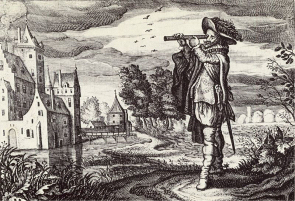 |
| Early depiction of a Dutch telescope, from the work "Emblemata of zinne-werck" (Middelburg, 1624) |
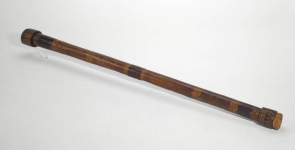 |
| Galileo's telescope. Credit: © Institute and Museum of the History of Science/Franca Principe. |
It was an age of exploration and discovery in Europe. While sailors and merchants set off to cross the oceans and chart the globe, scientists embarked on their own exciting journey - to probe the infinitely great and invisibly tiny. These investigations became possible at the turn of the seventeenth century with the invention of the telescope and the microscope, both credited to Dutch lens makers.
Settling the heliocentric question
Shortly after the invention of the telescope, Italian astronomer Galileo Galilei built his own version and was the first to observe the sky with an 'enhanced' eye in 1609. This inaugurated a new era in observational astronomy and fostered the development of modern, experimental science. The telescope allowed astronomers to gather ample evidence to test the heliocentric view of the Universe that had been proposed a few decades earlier by the Polish astronomer Nicolaus Copernicus.
The observations made by Galileo would open up the way for fundamental discoveries. Along with the laws of planetary motion formulated by the German astronomer Johannes Kepler, Galileo's work laid the foundations for the theory of universal gravitation. This theory, developed by English physicist and mathematician Isaac Newton, and published in 1687, removed any lingering doubt that the Earth revolves around the Sun.
The parallax view
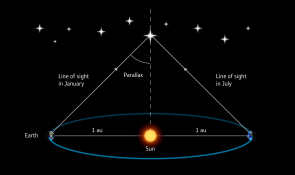 |
| The parallax method of measuring a star's distance. Credit: ESA/ATG medialab |
The availability of improved instruments and the acceptance of the heliocentric system gave astronomers renewed motivation to search for stellar parallax, a natural effect of Earth's annual motion around the Sun. The parallax is an apparent movement of a foreground object with respect to its background owing to a change in the observer's position. Astronomers thought that the Earth's orbit would provide a reasonably long baseline to detect stellar parallaxes and exploit these measurements to determine the distance to the stars.
New catalogues
Astronomy was not just for fun or curiosity: the expansion of maritime navigation demanded precise maps of the sky. This problem pushed the governments of some European states to support and fund the first great astronomical observatories.
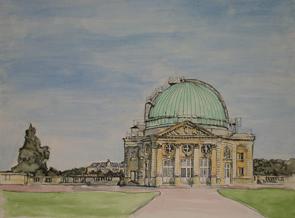 |
| The Paris Observatory. Credit: Julia Kostelnyk (from an original painting) |
Two major institutes that would push forward the charting of the skies were established in the late seventeenth century: the Paris Observatory and the Royal Greenwich Observatory. At the Royal Greenwich Observatory in London, English astronomer John Flamsteed compiled the first stellar catalogue with the aid of a telescope. Published in 1725, Flamsteed's catalogue listed the positions of almost 3000 stars with a precision of 10-20 arc seconds: this was a marked improvement on the one compiled just two centuries earlier by Danish astronomer Tycho Brahe.
Several decades later, in 1801, the French astronomer Jérome Lalande from the Paris Observatory would publish an even greater catalogue of 50 000 stars and a precision of around three arc seconds.
But the parallax of stars remained stubbornly undetected. The failure of astronomers to measure stellar parallaxes corroborated one of Newton's beliefs – that stars lie at enormous distances from us. However, astronomers were having some success in grasping cosmic scales by measuring distances within the Solar System.
Measuring the Solar System
In 1672, the Italian/French astronomer Giovanni Cassini estimated the distance between Mars and Earth. As director of the Paris Observatory, Cassini observed Mars from Paris while a colleague of his, French astronomer Jean Richer, performed the same measurement from Cayenne, in French Guiana. Comparing these simultaneous measurements, they estimated the parallax of Mars and used basic trigonometry to infer its distance, with the resulting value being within about seven per cent of the modern value. These measurements provided the first robust estimate of the size of the Solar System, which was 20 times larger than the first value guessed by Ancient Greek astronomers almost 2000 years before.
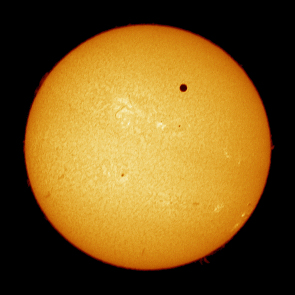 |
| The June 2012 Venus transit. Credit: ESA |
A similar experiment, proposed in 1716 by English astronomer Edmond Halley, suggested exploiting the transit of Venus across the Sun to determine the size of the Solar System. Halley didn't live long enough to take the measurements himself, but his idea inspired one of the largest international scientific enterprises accomplished up to that time. Several astronomers travelled to many different locations on the globe – including the Polynesian island of Tahiti and the Cape of Good Hope in South Africa – to observe the Venus transits of 1761 and 1769. From the combined analysis of these data, Jérome Lalande deduced the first robust estimate of the distance between Earth and the Sun. This estimate, published in 1771, was only a few per cent above the modern value of 149 597 870.700 km.
Halley was also the first to discover that stars are not fixed but are actually moving through space. He realised this in 1718 whilst comparing the positions of stars from contemporary catalogues with those recorded in Ptolemy's Almagest – a second century astronomical work that includes a catalogue of stellar positions commonly attributed to the Greek astronomer Hipparchus almost 2000 years earlier. Halley noticed that the position of some bright stars in the sky had changed substantially, and explained these displacements in terms of what is known as proper motion – the projection of a star's velocity in the plane of the sky.
Conquering parallax
Even more precise telescopes were being developed in the early nineteenth century, but in spite of the great technical progress, astronomers had not yet succeeded in measuring the parallax of stars. An interesting by-product of this search was the discovery of the aberration of light, credited to English astronomer James Bradley in 1725. This phenomenon, caused by the motion of Earth through space, results in an apparent motion of astronomical sources on the sky, which appear slightly displaced towards the direction of Earth's motion.
As the search for stellar parallaxes continued, the German astronomer Wilhelm Struve, who worked at Dorpat in Russia (now Tartu, Estonia), developed a criterion to make it simpler. He suggested focusing on stars that, on the basis of indirect clues such as their apparent brightness or proper motion, were likely to be located at relatively small distances. He contended that, if these stars were nearby, they must display a larger parallax that would be easier to detect.
Struve would go on to successfully measure the parallax of a star, but he is not regarded as the first to publish it. That honour went to his countryman, Friedrich Bessel. An astronomer and mathematician, Bessel was the first to publish a reliable measurement of parallax, in 1838. He detected an annual shift in the position of the star 61 Cygni amounting to 0.314 arc seconds, placing the star at a distance of about 10 light-years. Nowadays, 61 Cygni is known to be a binary star system, with parallax values of 0.287 and 0.286 arc seconds for the two stars.
Bessel used a special type of telescope, the heliometer, manufactured by the German physicist and lens maker Joseph Fraunhofer.
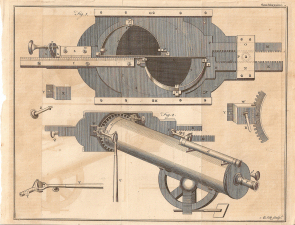 |
| Heliometer design. Image courtesy of Specula astronomica minima (©Specula astronomica minima) |
Originally developed to observe the Sun and measure its angular diameter, the heliometer consists of a lens cut in half: the two halves can slide with respect to one another, producing two images of the same source whose separation can be adjusted by turning a thumbscrew. This enabled Bessel to quantify minute differences in the relative positions of stars, eventually leading to his measurement of 61 Cygni's parallax.
Struve had only been narrowly beaten. While his early data on the parallax of the star Vega published in 1837 were not considered highly reliable, he continued his observations and in 1840 published a new measurement of 0.261 arc seconds. His value was twice that of the modern value of 0.130 arc seconds (corresponding to a distance of about 26 light-years) measured by ESA's Hipparcos mission. Struve also used a refracting telescope manufactured by Fraunhofer, and employed two parallel and fine wires to track nearby stars in the same field.
But there is another astronomer who could lay claim to the title of first to measure parallax. English astronomer Thomas Henderson, who surveyed the southern sky at the Cape of Good Hope in South Africa, conducted his measurements in the early 1830s, but only published the results in 1839. He reported a parallax of one arc second for the star Alpha Centauri. Now known to be a binary system, the best current estimates of the parallaxes of the two stars are 0.755 and 0.797 arc seconds. At a distance just over four light-years, the binary system of Alpha Centauri, along with the companion Proxima Centauri, are the nearest stars to the Sun.
The measurements were a triumph. Knowledge of astronomical distances allowed astronomers to calibrate their observations and to estimate physical parameters of stars, such as their luminosity and size, for the first time. The true immensity of the cosmos was finally becoming apparent and the next great development in the measurement of stellar positions was on the way.
Photography
The invention of photography revolutionised the practice of astronomy. The first photographs of the Moon and Sun appeared in the 1840s and the first photographic image of a star – Vega – was obtained by American astronomers William Cranch Bond and John Adams Whipple in 1850.
Now astronomers could directly capture a map of the sky on a photographic plate rather than looking through a telescope and transcribing their observations. This produced stellar catalogues that were much larger and more precise than had ever been possible.
In 1901, Dutch astronomer Jacobus Kapteyn used photographic observations to assemble a catalogue with the position and distances (obtained from parallax) of 58 stars; the catalogue grew rapidly to comprise 365 stars by 1910. At this time, other astronomers were performing even larger photographic surveys, among them the famous Carte du Ciel, reporting the positions of millions of stars, although with less precision.
Many more stellar surveys based on photographic observations, often taken with wide angle dedicated Schmidt telescopes based in both hemispheres, were assembled throughout the twentieth century, providing an ever more precise map of the entire sky. These remarkable data sets are the outcome of astrometry's long history, which had begun thousands of years earlier and made a phenomenal surge in the nineteenth century. As the twentieth century dawned, the measurement of stellar distances laid the foundations for even greater discoveries to come, ranging from the structure and nature of our Galaxy, the Milky Way, to the origin and evolution of the entire Universe.
